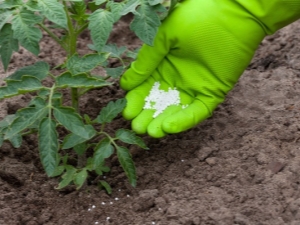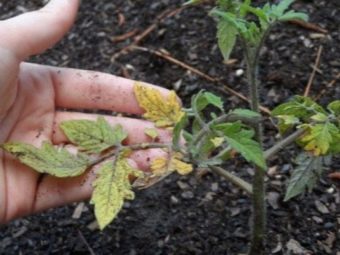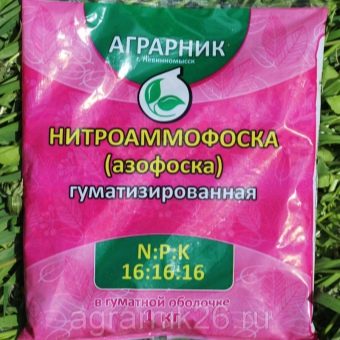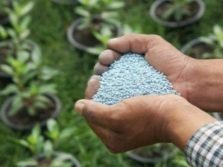How to feed tomatoes?

One of the secrets of getting a good tomato crop is regular fertilization.However, mindless feeding, as well as too frequent fertilization does not only contribute to increasing yields, but can also cause the death of the plant. It is necessary to figure out how to find a "middle ground", what fertilizers tomatoes need in different periods of the growing season.
Signs of micronutrient deficiencies
The sick, stunted appearance of a plant testifies to deficiency of microelements. However, each of the elements with its insufficient number signals this in a special way. So, yellow twisted lower leaves say that the plant is not enough nitrogen. This also indicates the appearance of small and weak leaves, fruits, thin young shoots, slowing the growth of the plant.
If the leaves have acquired a purple hue, while the temperature remains relatively stable (sharp frosts also provoke similar phenomena), this indicates a deficiency of phosphorus. The leaves curl inward and dry, their lower side acquires a reddish tint. On the roots appears bloom, and ripe fruits have a pronounced rusty tint.
But if the leaves roll out, while drying out and dying off, the plant most likely lacks magnesium. First, the yellowing of the leaf in the center occurs, after which it is completely affected. Another feature - this defeat is observed from the bottom of the bush to the top. Excessively light leaves indicate a lack of potassium. If the plant does not receive it in the near future, the leaves will begin to turn and dry.
Calcium deficiency is manifested by stunted plant growth, by drying its leaves. During the fruiting period, this is indicated by the unevenness of the color of the fruit. Thinning and flattening, the stiffening of the trunk of the bush indicates a lack of sulfur. This is indicated by the appearance of reddish-bluish streaks on the leaves of the upper shoots.
The fact that it is time to feed it with iron, the tomato says yellowed at the base of the leaves, changing the color of the apical leaves to a painful pale yellow, slowing the growth of the bush. If the gardener has found that the leaves starting from the roots are brightened, and the top of the bush is severely curved; if some leaves have brown streaks, the bush is very reluctant to bloom, and the formed fruits retain brown spots - all this indicates a boron deficiency.
However, the plant does not always report a lack of micronutrients with a stunted appearance. Growing a given culture a priori implies periodic introduction of top dressings, it is especially important to do this before flowering and during the formation of ovaries. Otherwise, the dates of fruiting may move, which will affect the yield. The lack of trace elements can cause the appearance of small fruits with an acidic core.
As a rule, deficiency of nitrogen, zinc, potassium, magnesium and phosphorus is manifested on the lower leaves, since these minerals, with an insufficient amount in the plant, are drawn by younger shoots. But it is not possible to “drag” iron, calcium, sulfur from old leaves with new leaves, so the deficit symptoms manifest in them.
Choosing fertilizer
Talking about fertilizer should not begin with a review of specialized and homemade dressings, which are used for root and foliar dressing of the bush, but with recommendations regarding soil preparation. Tomatoes like enriched, slightly acidified soil. They should contain turfy land, humus, peat, sand, as well as phosphorous and potash components. All variety of types of fertilizers can be reduced to such two groups as:
- organic - manure, peat, compost, cow or bird droppings, nettle infusion;
- inorganic or mineral - Nitrogen, potassium, phosphate, urea or urea.
Organic top dressings are of vegetable or animal origin. They serve not only to nourish the crop and increase yields, but also to protect it from disease.Among the most well-known organic products are humates, which make it possible to obtain a high-quality crop even on depleted soils, as well as yeast, especially necessary during the flowering period of the bushes, and ash. Ash provides culture with magnesium, calcium and phosphorus, which are necessary for its growth and development.
An important condition is to use ashes without impurities, remaining after burning pure wood, and not plastic.
Mineral fertilizers can be based on a single component, for example, nitrogenous, phosphoric, potash, or from several, such as Ammophoska, Nitrophosphorus. As a rule, in most cases it is sufficient to use the available one-component mineral dressings, which contribute to the different growth phases of the bush. For example, the use of nitrogenous fertilizers is justified if the formation of the root system and green mass is necessary, therefore the optimal time for their introduction is during planting of seedlings, as well as immediately after planting in the ground.
However, a week before the set of colors and after this period from the introduction of nitrogenous fertilizers should be abandoned. Since they will interfere with the bush to pick up color and form the ovary, in other words, it has a negative effect on fruiting.
During flowering, boron is the most essential trace element for tomatoes. To prepare solutions is extremely simple - it is necessary to make a solution of boric acid and water, taken in a 1: 1 ratio. In total, during the flowering period, two such dressings are needed to prevent the color from falling off, to stimulate pollination, and also to increase the sugar content in fruits. Potassium fertilizers have a complex effect, activating the immune system of the culture, preventing the development of diseases and promoting the growth and strengthening of the roots.
In addition, these supplements made during the fruiting period, accelerate the ripening of the crop and improve its taste.
Choosing potash supplements, it is recommended to give preference to sulfates. Potassium chloride is introduced only into the soil during its preparation for the winter.
The complex mineral compositions include Ammofosku, containing nitrogen and phosphorus and the most useful for greenhouse tomatoes. Based on nitrogen, potassium and phosphorus, Nitrophoska and Nitroammofoska are prepared. The first fertilizer is applied during the digging of the earth and in the planting of tomatoes. The second option has a similar purpose, but also demonstrates its effectiveness as root dressing, which is not the case with Nitrophoska. Potassium nitrate based on potassium and nitrogen will also prove useful during the preparation of tomato ridges.
If mineral components are added to an organic base, complex organic fertilizer will be obtained. Among the most famous ready-made compositions of this group is worth noting fertilizer "Baby". Organic matter is represented by dolomite flour, sand, and peat. Nitrogen and phosphorus act as the mineral component. "Baby", more precisely, the solution, which is prepared from it, is suitable for use in transplanting seedlings, as well as root dressing for an adult plant.
During planting, as well as for adult bushes, you can add a mixture of humic components, bacteria and minerals called "Signor Tomato".
As for mineral supplementation, it is mandatory to fertilize the crop 10–14 days after transplanting seedlings into the soil or greenhouse. To do this, you can fertilize with superphosphate, yeast compounds, urea solution and "Nitroammophosphorus". During flowering recommended "superphosphate" and "nitroammophosphorus." “Grandfather's” recipes will also work - this is a yeast top dressing, as well as a solution based on potassium sulphide and litter or cowshed, diluted with water.
Potash fertilizers are necessary during fruiting, and iodine supplementation has proven its effectiveness. When root making it stimulates the formation of ovaries and is the prevention of powdery mildew.An insufficiently large crop can be increased by using iodine whey with the addition of cow's milk.
Folk recipes
To feed tomatoes it is not necessary to acquire specialized drugs, because a tool with a similar effect can be done at home. This is exactly what many gardeners are doing, rightly noting the greater safety of self-made solutions in comparison with the purchased versions.
However, it is important to understand that in case of non-compliance with the concentration and time of fertilizer application for a plant, and sometimes a person, the feeding with Nitrophen and whey with iodine may be equally dangerous. The application of a top-dressing prepared according to a popular recipe can be made 10–14 days after planting, and then every 2 weeks until mid-July.
Many experts use several options for feeding their own home-made tomatoes.
- To increase the yield, improve the absorption of minerals and prevent the development of late blight allows iodine dressing. To prepare it, 4 drops of iodine solution should be thoroughly mixed in 10 liters of water, after which the plant should be watered at the rate of 2 liters per bush.
- Foliar iodine dressing involves the preparation of whey, for which a glass of milk and 25 drops of iodine is added to 1 l of water. The resulting mixture is diluted with water at a ratio of 1:10 and sprayed onto the bushes in the evening or morning time at the rate of 1 l per one bush.
- To grow seedlings you can prepare yeast dressing. To do this, dilute 10 g of yeast with 10 liters of water, mix everything thoroughly, and then dilute the solution with clean water in a ratio of 1:10. . You can add chopped herbs to the yeast dressing, chicken manure. The effect will be noticeable very soon - approximately 5–7 days after fertilization.
- Another recipe for yeast dressing involves the use of 100 g of live yeast and ½ cup of granulated sugar, which are poured with three liters of warm water. The composition must be mixed and left to ferment. The resulting "mash" diluted with water 1:10, and also feed the tomatoes until flowering.
- Has a similar effect and bread feeding. The use of the composition on the basis of black bread allows to enrich the soil with nitrogen, potassium, phosphorus, iron. One of the recipes involves filling an 8-liter bucket with crusts of black bread, the remaining volume is filled with water. Bread should be pressed with a plate on which to set the load to prevent the emergence of crusts. The composition is infused weekly in a dark place, then filtered, diluted with 3 liters of pure water and used for watering. Consumption rate - 0.8–1 l per bush.
- The lack of boron, as evidenced primarily by the poor formation of ovaries and brown spots on tomatoes, can be leveled with feed based on boric acid. On a bucket of water, 15 mg of the latter is taken, carefully stirred and watered with the calculation of 1 liter of the mixture per bush. Based on this composition, it is possible to prepare a complex mineral fertilizer — 15 ml of boric acid and 4 liters of ash are taken to a bucket of boiling water. Infusion time - day, after which the solution is filtered and used for irrigation at the rate of 1 liter under a bush.
- Accelerate the ripening of fruits for 3-5 days, improve their taste and aesthetic characteristics allows composition of superphosphate with sodium humate. The first will require 30 g, the second - 10 g. The components are dissolved in a bucket of warm water, the flow rate per bush is 1 l.
Feed schemes
The scheme for applying top dressing for tomatoes growing in the open field, and the scheme for greenhouse bushes do not differ from each other. The first feeding is done a few weeks after planting seedlings in the ground or greenhouse.Next - during flowering, the third falls on the period of formation of ovaries. Finally, the last, fourth dressing, recommended during fruiting. Its goal is to ensure harmonious ripening of the crop, increasing its taste and visual appeal.
Before the first feeding, it is recommended to water the plants with a weak solution of potassium permanganate, and then add potassium nitrate. In the future, feed tomatoes with potassium and manganese should only be subject to a pronounced lack of these components. The first dressing is used to form the immunity of the bushes, strengthen their roots, build up green mass. Organic fertilizers have a higher concentration, so they are used in smaller quantities.
Manure is widely used as a source of nitrogen. However, when fresh, it can cause a burn. In addition, when used in this form, it is likely to bring pests, helminth eggs, to the spore site. In this regard, fresh manure during the digging of the site in the fall is buried in ridges, an average of 6 kg of manure per 1 m² is used.
Manure can also be applied in the spring as a root dressing, for which 2.5 kg of humus is dissolved in a bucket of water. The resulting composition is again diluted with water 1:10, and watered it with tomatoes.
A high concentration of nitrogen is also contained in bird’s (more often chicken) manure, which is used as root dressing. To do this, it is diluted with water. It is extremely rare, with a strong lack of nitrogenous compounds in the soil, droppings are dropped into ridges (200 g of raw materials are required per 1 m²). When using a more convenient granulated form of organic matter, it is recommended to make it twice per season — during planting of seedlings in the ground or greenhouse and during growth (after 2–2.5 months).
The need for rare introduction is due to the fact that nutrients in such formulations have a long period of release of nutrients, up to three months. According to this scheme, make "Minigran", "Biogran."
After landing in the ground, you can make yeast dressings, the recipe of one of them is listed in the section above. On the bush requires about 1 liter of fertilizer. Iodine supplements are also carried out infrequently - during the development of seedlings, as well as during fruiting. Of course, the maximum benefit will bring dressing, conducted taking into account the characteristics of the composition of the soil and the analysis of the state of the culture.
However, we can recommend the general scheme, which is suitable in most cases, provided that the tomatoes do not have a pronounced deficiency of a certain microelement.
In the soil prepared from autumn and re-dug, you need to make holes for tomatoes. In each of them to make a scoop of the finished compost, one tablespoon of ash and "nitrophosphate." Then the well should be moistened with a weak solution of potassium permanganate and transplant seedlings. After 10 days it is recommended to fertilize the bushes with useful microflora. Consumption - 1 watering can for 3 m².
To do this, you can purchase special preparations with beneficial microorganisms and dilute them with water, following the instructions. You can prepare a similar composition on your own by adding a tablespoon of honey to a liter of river or rain water. After this composition should be left in a dark place for a week. The resulting solution should be taken in the amount of 1 tablespoon and add to 10 liters of water. After that, mix and use for watering.
In the period of the formation of the first stepsons, iodine-milk whey can be used, which is also the prevention of phytophthora. When forming the fruit, it is necessary to provide the plant with a sufficient amount of potassium. To do this, in a bucket of water should be mixed 35 g of potassium sulphide, 5 g of urea and 30 g of superphosphate. Watering the resulting solution bushes should be every 10 days, fertilizer consumption - at least 1 l per bush. To accelerate the maturation of the crop allows a solution of 3 g of potassium permanganate, 1 g of boric acid and ½ g of sulfur, diluted in 10 liters of water.
As for feeding the seedlings, then with sufficient care, proper preparation of the soil and seeds, the abundance of light and heat, the seedlings can do without feeding. If the young bushes look weak and haggard, you can feed them with the Agricola complex mineral fertilizer. Periodically, no more than once every 2 weeks, it is permissible to water the seedlings with a weak solution of potassium permanganate. After the picking, you can water the seedlings with the drug “Kornevin” or similar ones, although it is wrong to say that feeding was done.
"Kornevin" is a biostimulating drug. Fertilizers at this stage of development of tomatoes are not required.
All conducted feeding, regardless of the formulations used and the timing, can be divided into two types, such as:
- root;
- foliar.
Based on the name of the methods, it is clear that in the first case, the nutrient solution is poured into the soil, from where it is absorbed by the roots, in the second case, the useful substances get inside the plant from the surface of leaves and shoots. At the same time, the rate of assimilation of fertilizer components during foliar feeding is faster. As a rule, foliar feeding or spraying is resorted to, if necessary, to strengthen the plant's immunity, when detecting the first signs of culture-related diseases, accelerating the formation of ovaries and increasing their number.
Spraying is also useful as a first feeding, especially with significant damage to the root system during transplantation. Damaged roots cannot fully absorb fertilizer, which is not the case with leaves. Finally, spraying, as a rule, is a less labor-intensive process; it makes it more economical to use specialized preparations.
Since spraying involves the ingress of moisture on the leaves and the bush as a whole, it is therefore important that at this time they are not exposed to sunlight. To do this, foliar feeding of tomatoes growing in the open field is carried out in the evening when solar activity decreases. When growing greenhouse culture, the procedure, on the contrary, is carried out early in the morning, since in the evening its efficiency will be reduced due to an increased concentration of moisture and fumes. For root and foliar feeding you should use different formulations.
The first are too concentrated, so when they hit the surface of the leaves can easily destroy them. The latter, when introduced into the soil, will turn out to be poorly concentrated, which means they will not be beneficial.
With a lack of nitrogen, you can spray the bushes with urea, for which 70–80 g of urea is diluted in a bucket of water. Boric acid added to the composition for root fertilizer can also be used for spraying. To do this, in 1 liter of water put 1 g of boron. The latter is dissolved only in hot water, which should be remembered when preparing the solution. After the composition has cooled, they can spray the bushes. One liter is enough for 7-8 plants. Boric foliar top dressing is recommended when dropping color, in the period of fruit set.
Iodine, calcium nitrate, ash, "Fitosporin" - all this can be used as a basis for preparing solutions for irrigation. As a rule, all of the listed components, except for calcium nitrate, are used when detecting the first signs of disease, reducing plant immunity. Saltpeter also contributes to more active photosynthesis, allows the crop to better absorb nitrogen, increases yields.
Tips
It is necessary to comply with the following simple recommendations what will allow to carry out top dressing with the maximum advantage for culture:
- the bushes should be fertilized immediately after watering, otherwise, because of the too high biological activity of top dressing, the roots of the plant may be burned;
- do not exceed the maximum amount of top dressing per bush, which is equal to 1 l; in general, the amount of fertilizer applied depends on the size and growth period of tomatoes and ranges from 400 ml to 1 l;
- if in the autumn a sufficient amount of organic matter was introduced into the soil, then during the growing season of the crop, the amount of mineral supplements should be reduced, otherwise tomatoes may contain elevated levels of nitrates;
- during the rainy season, tomatoes grown in open field require larger amounts of fertilizer than their greenhouse “relatives”; This is logically explained by the fact that some of the useful components are simply washed out of the ground during precipitation;
- inexperienced gardeners are often lost in fertilizer application schemes; The simplest method is the following: 14 days after planting the seedlings, the first dressing should be carried out, and the following should be repeated every 2–2.5 weeks, and the crop should be fertilized 2 weeks before harvesting;
- when choosing potash supplements, you should carefully study their composition, for example, potassium chloride is not suitable for these purposes, while potassium sulfate, and even better, natural wood ash will be the best option;
- it is better to bring phosphorus from the fall during the digging of the plot; if this has not been done, then it is permissible to bring this component no later than 2-3 weeks before the transplanting;
- it is useless to apply nitrogen if phosphorus is absent in the soil, since it is the latter that promotes the assimilation of nitrogenous fertilizers by tomatoes; In this connection, it is better to combine superphosphate with organic matter than simply adding the latter, which is rich in potassium and nitrogen, but not containing phosphorus;
- when using purchased mineral preparations along with organic matter, the amount of the first should be reduced to avoid burning the roots;
- experienced gardeners usually use some kind of fertilizer, which is applied according to a specific scheme; depending on the vegetation stage and the peculiarities of the state of the plant, it is combined with others;
- fatty soil is for tomatoes in most cases more destructive than the one in which there is a shortage of some elements; on fat ground, the culture begins to “fatten”, as evidenced by the lush greenery, the large height of the bush and the complete absence or insignificant number of ovaries, therefore such a bush may not produce a crop or it is too late to enter the fruiting period, because of which the fruits do not have time and keep up before the onset of frost;
- one should not produce more than three additional feedings using the cowshed in one season, since this may provoke an increase in the soil fat content and an increase in nitrogen in it above the permissible values;
- it is desirable to exclude root fertilizers with urea, it is recommended to prepare formulations for foliar feeding of tomatoes from the latter;
- during foliar application, it is important to follow the manufacturer's instructions precisely, because too strong, as well as a weak concentration of the preparation for spraying, does not allow to achieve the desired effect; Test spraying will also be useful - selecting the desired drug with a suitable concentration, spraying individual bushes and observing the reaction of tomatoes.
Proper feeding of tomatoes allows not only to get a higher yield, but also increases the resistance of the crop to diseases. However, it should be remembered that even with the observance of the rules of fertilizer application, but in the absence of proper care of the bushes, it is impossible to grow a good crop, and sometimes save the bushes from diseases and micronutrient deficiencies.
In other words, dressing bushes should be only one of the areas of care for them.
How and how to feed the tomatoes, see the following video.



























































